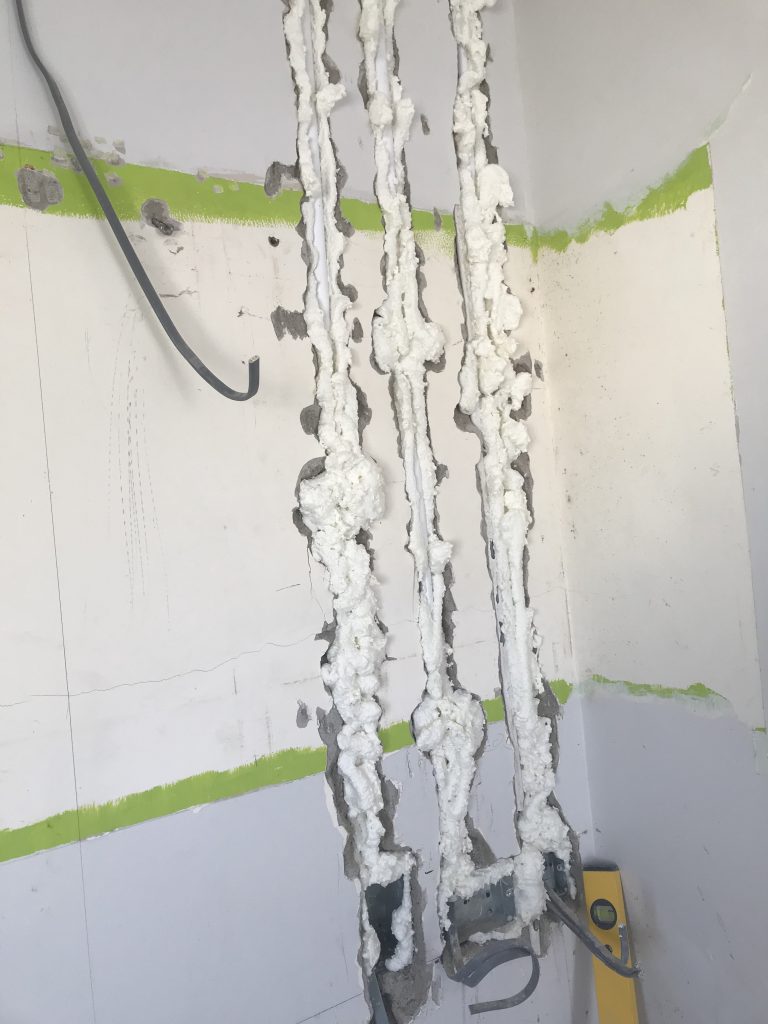Can You Plaster Over Expanding Foam?
Urgh!! Expanding foam. I shudder at the thought of expanding foam. For some reason, there are people and even tradespeople that think expanding foam is suitable for filling holes for a plasterer to plaster over, and frankly, I have never found a good use for expanding foam when plastering. Lets look at whether you can plaster over expanding foam.

What is Expanding Foam and When to Use It
Expanding foam is a polyurethane-based product designed to fill large gaps and cavities in walls, ceilings and floors. It comes in two forms – aerosol cans that are released as small beads of foam or large sealant gun cartridges filled with liquid-expanding foam. The idea is to fill the large gap with expanding foam, allow it to expand, cure and then plaster over it.
It is important to note that expanding foam should only be used in areas where it will not be visible. It is an effective tool for filling larger spaces, like between two walls or a cavity wall insulation system. However, it is unsuitable for plastering over due to its chemical makeup and tendency to expand outwards, causing cracks and bumps on the surface of your plasterwork.
What are the Benefits of Plastering Over Expanding Foam
There are no benefits for plastering over expanding foam at all. The only time I come close to plastering over expanding foam is when the window fitters have been in and used explosives to remove the windows and then have gone on to use expanding foam to hold the window in and fill any draughty bits.
When this happens, then you have very little choice but to plaster over expanding foam. Unless the window fitters have unleashed the plastic trim brigade, which will cover 100mm of blown, expanding foamed filled wall with hideous plastic trim, then you will need to plaster over the expanding foam.
How to Prepare the Surface Before Plastering
As with most things relating to plastering, there are always more ways to do the same task, and some plasterers will argue that their way is either the correct way or a better way. However, the way I do things is the way I do things and seeing as I am the one writing this, I see it only right to show you the way I know.
For small areas less than 20mm wide, the first thing I would do is get that expanding foam 10mm or more back behind the surrounding plaster, and if that means removing some of it, then so be it. I also push and squeeze the foam until I am confident it is back far enough.
I would then apply a backing plaster (normally Bonding Coat) and push it into the hole, making sure it is completely filled, and then I would leave it to set.
Once the bonding plaster has set, I would get my trowel and scrape the surface flat and even a little concave if possible. I would apply a fine-fill filler like Easifil or MultiFinish plaster, which should do the trick.
If the area of the expanding foam that needs plastering is bigger than 20 mm, I suggest entirely removing the expanding foam and finding an alternative way. If, by unfortunate circumstances, I have to plaster over this massive patch of hell, then I would likely look to use some plastic render mesh or expanding metal lath (eml) and bed that in with bonding plaster, but this would be a last resort. I really do not like plastering over expanding foam.
So Can You Plaster Over Expanding Foam?
Can you plaster over expanding foam? Yes, you can, but it is not a good idea, and you need to find ways to avoid plastering over expanding foam at all costs.
If you have enjoyed or at least found this post on can you plaster over expanding foam? please make sure you follow us on Facebook and look out for more great topics. All these posts are written by a plasterer and are designed to help answer the most common questions in the plastering and construction industry.